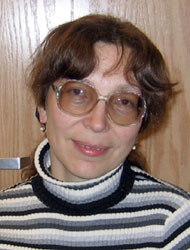 |

For further information, contact the MBL Communications Office at (508) 289-7423 or e-mail us at comm@mbl.edu
For Immediate Release: June 13, 2007
Contact: Gina Hebert, MBL, 508-289-7725; ghebert@mbl.edu
 |
|
Irina R. Arkhipova
|
|
Chromosome Ends: The Beginning
MBL, WOODS HOLE, MA—Most enzymes don't become as famous as telomerase, which has been nicknamed "the fountain of youth" due to its ability to extend the lifespan of human cells in culture. One of the important roles of telomerase is to maintain the tips of chromosomes, called telomeres, in good health. Telomeres naturally shorten with each cell division, but if they become too short, serious problems can result, including chromosomes getting stuck together, degrading or incompletely replicating during cell division. Telomerase comes to the rescue by extending and thereby maintaining the telomeres. It does this by a specialized reverse transcription process, in which the telomerase copies an associated RNA template into DNA directly at the chromosome end.
Given the importance of telomerase, its evolutionary origin is of keen interest to researchers. In the May 29 issue of the Proceedings of the National Academy of Sciences, a clue to the enzyme's evolutionary ancestry is presented by Irina R. Arkhipova of the MBL's Josephine Bay Paul Center and Harvard University and her colleague, Eugene A. Gladyshev of Harvard.
Arkhipova's and Gladyshev's research focuses on Penelope-like retroelements (PLEs), which are mobile genetic elements containing a reverse transcriptase gene. Penelope-like retroelements have been identified in more than 50 species belonging to at least 10 animal phyla. In this study, Arkhipova and Gladyshev describe a subset of PLEs that are found at the telomeres in four eukaryotes from different kingdoms: bdelloid rotifers (animal), basidomycete fungi, stramenopiles (protist), and plants. These telomere-associated PLEs lack an endonuclease domain, meaning although they can make copies of themselves, the copies cannot move around and insert elsewhere in the genome (which most "invasive" retroelements do), but can only insert at the telomeres. Strikingly, this lack of an endonuclease domain is also found in the telomerase reverse-transcriptase gene - a situation not known in any other reverse transcriptases.
In their paper, Arkhipova and Gladyshev hypothesize that the telomere-associated PLEs may descend from the missing ancestral link between early eukaryotic retroelements and present-day telomerases. They also posit that similar retroelements could have facilitated the evolutionary transition from circular chromosomes in prokaryotes to linear chromosomes in eukaryotes.
Arkhipova is a member of the Mobile Genetic Element Cluster at the Josephine Bay Paul Center, which was formed in 2005. Mobile (transposable) genetic elements are found in almost all genomes, and represent more than 40 percent of the human genome. Thus, they have a significant impact on the ever-changing architecture of the human genome. Arkhipova and the four other investigators in the Mobile Genetic Element Cluster are interested in two broad, basic questions: What are the molecular mechanisms that lead to genetic transposition; and how do transposable elements impact an organism's lifestyle? Their research on transposable elements is also relevant to important medical issues, including the development of anti-HIV therapies, of vectors for genetic transformation of invertebrates such as disease-carrying insect populations, and of therapies to combat bacterial pathogen-related diseases in humans.
RESOURCES:
Citation:
Eugene A. Gladyshev and Irina R. Arkhipova (2007)"Telomere-associated endonuclease-deficient Penelope-like retroelements in diverse eukaryotes." Proc. Nat. Acad. Sci. USA, Vol. 104, No. 22 (May 29), pp. 9352-9357.
Authors:
Irina Arkhipova, Assistant Research Scientist at the Josephine Bay Paul Center for Comparative Molecular Biology and Evolution, Marine Biological Laboratory; and Staff Scientist, Department of Molecular and Cellular Biology, Harvard University.
Eugene A. Gladyshev, Graduate Student, Department of Molecular and Cellular Biology, Harvard University.
This work was supported by the National Science Foundation (MCB 0614142).
Web links:
|